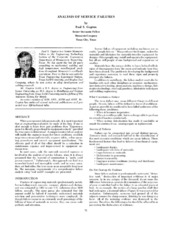| dc.description.abstract | When a component fails prematurely, it is most important that an engineering evaluation be made of the loss. If one is alert enough to learn from past problems then "Experience gained is directly proportional to equipment ruined, "provided the true cause is determined. A comprehensive failure analysis will enable the engineer to predict future problems, establish inspection criteria and intervals, improve safety, refine operating procedures and correct equipment specifications. The ultimate goal of all of this effort should be a reduction in maintenance expense and improvement in equipment on-stream time. In most cases, only the materials oriented engineer is involved in the analysis of service failures, since it is always presumed that the material of construction is "guilty until proven innocent." Unfortunately, this approach can lead to a somewhat biased and incomplete result, and in many cases, does not find either the true cause or an acceptable long term fix. The necessary requirements of a comprehensive failure analysis using "real world" examples are presented. | en |


